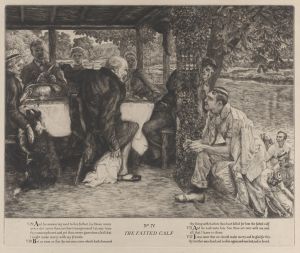
La demoiselle de magasin
A hand-painted replica of James Tissot’s masterpiece La demoiselle de magasin, meticulously crafted by professional artists to capture the true essence of the original. Each piece is created with museum-quality canvas and rare mineral pigments, carefully painted by experienced artists with delicate brushstrokes and rich, layered colors to perfectly recreate the texture of the original artwork. Unlike machine-printed reproductions, this hand-painted version brings the painting to life, infused with the artist’s emotions and skill in every stroke. Whether for personal collection or home decoration, it instantly elevates the artistic atmosphere of any space.
James Tissot's painting "La Demoiselle de Magasin" is a notable work from the 19th century, reflecting the artist's keen interest in the social dynamics and fashion of his time. Created in 1883-1885, this painting is part of Tissot's broader exploration of modern life, particularly focusing on the roles and experiences of women in society.
James Tissot, a French painter and illustrator, was renowned for his detailed and vibrant depictions of contemporary life. He was born on October 15, 1836, in Nantes, France, and studied at the École des Beaux-Arts in Paris. Tissot's career spanned several decades, during which he became known for his genre paintings that often featured elegantly dressed women in fashionable settings.
"La Demoiselle de Magasin" translates to "The Shop Girl" in English, and the painting captures a scene inside a fashionable boutique. The artwork is characterized by Tissot's meticulous attention to detail and his ability to capture the nuances of social interaction. The painting depicts a young shop assistant, or "demoiselle," engaged in her work, surrounded by luxurious fabrics and garments. This setting provides insight into the consumer culture of the time, as well as the emerging role of women in the workforce.
Tissot's work is often noted for its realism and the way it reflects the societal norms and expectations of the late 19th century. In "La Demoiselle de Magasin," the artist portrays the shop girl with a sense of dignity and professionalism, highlighting her role within the commercial environment. The painting also reflects the growing importance of department stores and the retail industry during this period, which were becoming central to urban life and the economy.
The composition of the painting is carefully arranged to draw the viewer's attention to the shop girl, who is positioned prominently in the foreground. Her attire is fashionable yet practical, reflecting her status as both a participant in and a facilitator of the fashion industry. The surrounding elements, such as the rich fabrics and elegant decor, emphasize the opulence and allure of the shopping experience during this era.
Tissot's ability to capture the subtleties of light and texture adds depth to the painting, creating a vivid and immersive scene. His use of color and detail not only brings the setting to life but also underscores the themes of commerce and femininity that are central to the work.
"La Demoiselle de Magasin" is part of Tissot's larger body of work that often explores themes of modernity, fashion, and the changing roles of women. His paintings provide a window into the social and cultural landscape of the 19th century, offering insights into the complexities of identity and class during this transformative period.
Overall, James Tissot's "La Demoiselle de Magasin" is a significant example of his artistic style and thematic interests. It remains an important work for understanding the interplay between art, society, and commerce in the late 19th century, and it continues to be appreciated for its historical and artistic value.













